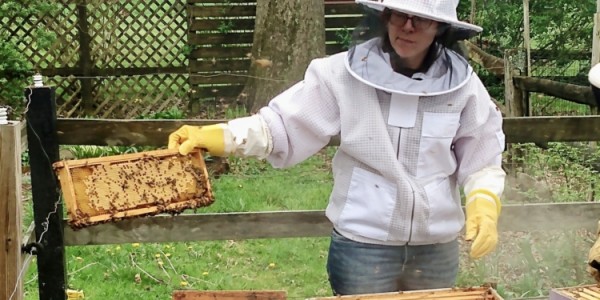
I was invited by Mare and Richard Olsen to spend a breezy, beautiful Sunday afternoon at their “Gooseberry Farm” – or “Tikerberi talu” in Estonian – where they recounted their beekeeping journey.
Mare, originally from Valga, Estonia, and her husband Richard have been keeping bees for fifteen years. As Richard explains, “When I retired in 2008 Mare declared, ‘You have to do something.'” They had heard about beekeeping, took a course, collected equipment, and began their bee odyssey. Richard credits bee-whisperer Rich Lepik as their mentor, who taught them how to remove honey from the hives. “Other people use harsher methods, but Rich showed us how it can be done gently, without bothering the bees,” recounts Richard.
“We started with two hives, and have had as many as five, although we have three now,” states Mare.
Some effort and time are necessary with this undertaking. As Mare details, “To keep the bees healthy, the hives need to be regularly treated for varroa mites, parasites which can devastate an entire hive if left unchecked.”
The hive’s health depends on its population density. “Collecting nectar and pollen when everything is blossoming, and the queen busy laying eggs, the pressure in the hives grows. If a hive can’t accommodate the increase in bees, then some prepare for a big, important event: swarming. Some of the bees break off from the colony, following the scout bees searching for a new home.”
Richard is on the Morris County list for swarm removal. If bees have been unable to find a suitable spot, the swarm might stop in the upper branches of trees, in bushes – really anywhere. That’s when Richard and Mare rush to the rescue. If they are able to collect the swarm in a container or box, they then have to find a new home for the swarm. Mare narrates, “Maybe a beekeeper has lost a hive for whatever reason, or a new beekeeper is in search of bees. If the queen bee is in the middle of the swarm, then they don’t have to buy a new one. [Queen bees can be ordered from catalogues!] Once a new hive has been located, we situate the box of bees in front of it and it’s amazing to see the troop march in a calm, organized, disciplined column, stoically, with purpose and intention into their new home.”
Advertisement / Reklaam
Advertisement / Reklaam
https://www.vabaeestisona.com/...


